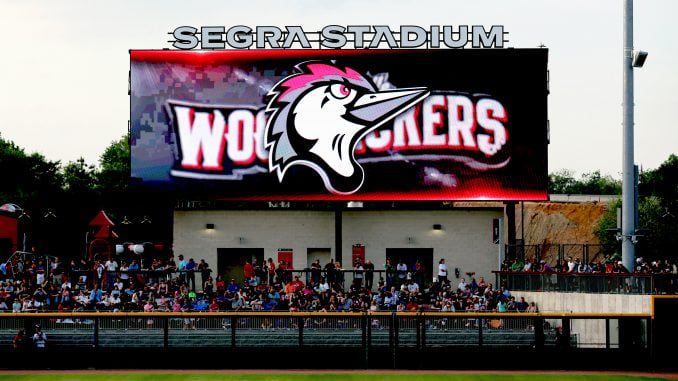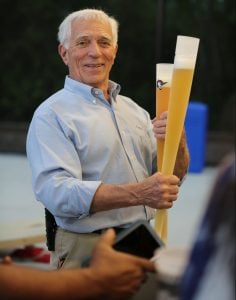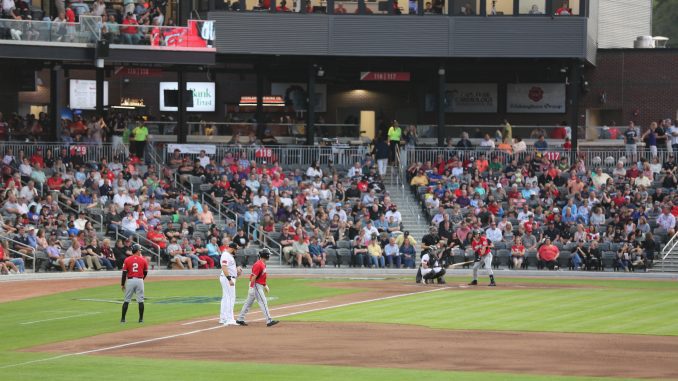
FAYETTEVILLE — Back in 1996, an architect named Robert Marvin was hired to devise a revitalization plan for Fayetteville’s decaying downtown area.
The centerpiece of his design was a controversial 60-foot high mound to be built using dirt dredged from the creation of several manmade lakes.
“Marvin’s Mound,” as it derisively came to be known, never got off the drawing board.
It took more than two decades for a new downtown revitalization plan to be put into place. But last Thursday, it finally became a reality.
And, surprisingly, it also centered around a mound.

This one, however, rises less than a foot above the ground and is located 60 feet, 6 inches from home plate in Segra Stadium, the new state-of-the-art home of the Carolina League’s Fayetteville Woodpeckers.
“There are really no words to describe this,” said community leader George Breece, a lifelong Fayetteville resident, looking around the 5,200-seat ballpark filled with fans for its debut between the Woodpeckers and Carolina Mudcats.
“A downtown stadium has been a dream for at least two decades. To see this come to fruition means a lot to me. I’m glad I lived long enough to see it.”
The Woodpeckers are a Class A affiliate of the Houston Astros, owned and operated by the major league franchise.
Although they are the first minor league team since 2000 to call Fayetteville home, the Woodpeckers’ arrival is actually the continuation of a long, storied relationship with professional baseball.
Babe Ruth hit his first home run there during spring training while playing for the International League’s Baltimore Orioles. Jim Thorpe lost his amateur status and subsequently an Olympic medal because he failed to use an assumed name while playing ball there one summer.
Dozens of future major leaguers came through the city playing both for and against previous affiliated minor league incarnations.
That pipeline dried up when the most recent entry, the Cape Fear Crocs, was sold and moved to Lakewood, N.J. Subsequent efforts to attract another team were thwarted, in large measure because Fayetteville’s old stadium did not meet minimum standards set by the National Association of Professional Baseball Leagues.
“This area has a rich tradition of baseball,” said Astros president Reid Ryan. “It just never had a world-class facility.”

The idea for a downtown ballpark first came about around the same time as the Marvin Plan. A site was even selected for construction. But when leaders representing the city and Cumberland County failed to agree on how the project would be financed — after years of debate — a jail was built on the land instead.
It wasn’t until 2016 when the Astros began looking for a place to put their Class A team as part of a move from the California League that also brought the Down East Wood Ducks to Kinston, that talk of a new stadium began to heat up again.
The biggest selling point was that the Astros were willing to sign a 30-year lease on the ballpark, guaranteeing it will have a tenant at least through the 2049 season.
“We wanted to make a long-term commitment,” the Astros’ Ryan said. “What that does is gives the people of this city and their leaders an assurance that we’re not going anywhere. It also makes people want to do things right.”
Tucked between Fayetteville’s Amtrak station and the historic Prince Charles Hotel, which is being renovated to become high-end apartments, Segra Stadium has all the bells and whistles of most modern minor league stadiums — including a large video board in left field, a vibrant beer deck in right, LED lighting and several luxury boxes.
The $40 million facility will eventually be surrounded by a hotel and retail complex still under construction.
“What I love about baseball is that every stadium has its own unique character,” Ryan said. “With the train tracks, Hay Street and how funky this piece of property is, it’s going to be a neat little experience when people come out there.”
Although the ballpark is home for a minor league franchise, Fayetteville mayor Mitch Colvin said it is a major league addition to a city rapidly outgrowing a once-seedy past.
“It’s been an amazing journey, and this is an exciting time,” Colvin said. “You see by the enthusiasm of the fans that the city was waiting for this. I think the citizens realize now that the investment was good and this is a nice entertainment source.”
With the possible exception of the two Army paratroopers that missed their target and nearly landed in the path of an oncoming train during a windy pregame ceremony, those in attendance at Thursday’s opener seemed to enjoy themselves.

The Woodpeckers lost 7-5, but leadoff hitter Bryan De La Cruz went into the books as having recorded the first hit in stadium history. That’s no small distinction, considering that the first hit in Fayetteville’s former ballpark, J.P. Riddle Stadium, came off the bat of a Gastonia Rangers prospect named Sammy Sosa.
Because it took the better part of two years to clear the land and complete construction of Segra Stadium, the team now playing in it was forced to spend last season going by the name the Buies Creek Astros in a temporary home at Campbell University.
That wait was nothing, Woodpeckers season ticket holder Mary Mercer said, compared to the two decades it took for Fayetteville to get its downtown mound and a new team to pitch from it.
“I never really knew how much I missed it until it came back,” said Mercer as she surveyed the opening night scene from her seat behind home plate. “I kind of got a little emotional when I got here tonight. To be able to just sit here and enjoy it is really good.”


